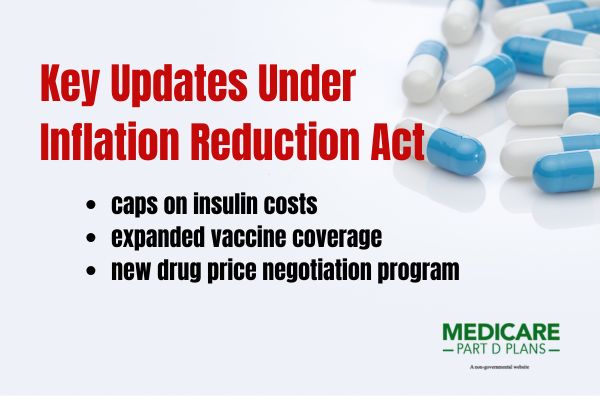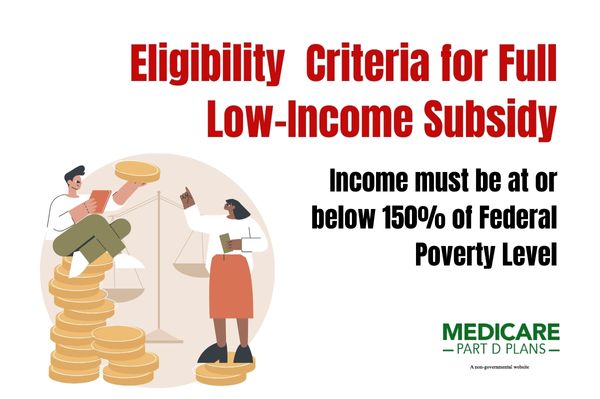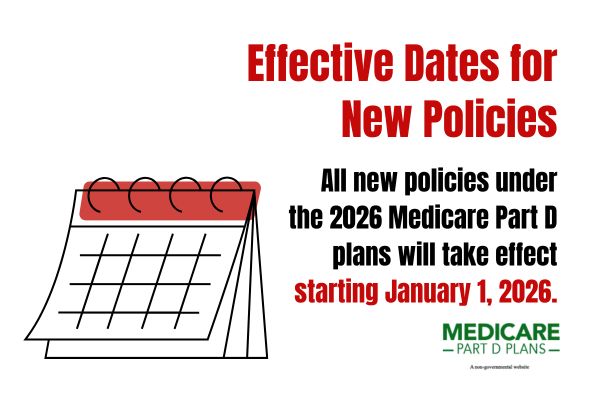Find a Medicare Part D prescription drug plan

Medicare Part D
Prescription Drug Coverage 2026
Medicare Part D Plans 2026
Curious about the changes coming to Medicare Part D Plans
Key Takeaways
In 2026 , the standard initial deductible for Medicare Part D will increase to $615, while the out-of-pocket spending limit rises to $2,100, impacting beneficiaries’ costs during the coverage phases.- The Inflation Reduction Act introduces critical updates including a $35 cap on monthly insulin costs, expanded vaccine coverage, and a drug price negotiation program aiming to reduce expenses for high-cost medications.
- Enrollment in Medicare Advantage plans is on the rise, with more than half of eligible beneficiaries participating, driven by benefits such as lower costs and integrated services compared to standalone Prescription Drug Plans.
Overview of Medicare Part D Plans for 2026
Medicare Part D plans are evolving to better serve beneficiaries
Additionally, beneficiaries will see adjustments in their out-of-pocket spending limits and enhanced coverage during the catastrophic phase. These changes are influenced by the Inflation Reduction Act, which aims to lower prescription drug costs and provide enhanced benefits for enrollees.
The following sections will break down these updates in more detail.
Standard Initial Deductible Increase
This deductible adjustment aims to balance program sustainability with quality drug coverage standards.
Out-of-Pocket Spending Limit Adjustment
The out-of-pocket spending limit for Medicare Part D will rise to $2,100
This new out-of-pocket spending cap will take effect on January 1,
Catastrophic Coverage Phase Benefits
Starting January 1, 2024, Medicare beneficiaries will benefit from zero cost-sharing for formulary drugs during the Catastrophic Coverage phase. This significant change means that once enrollees reach the catastrophic threshold, they will not have to pay out-of-pocket for covered formulary medications, enhancing the Part D benefit and easing the financial burden on those with high prescription drug costs.
Key Updates Under the Inflation Reduction Act
The Inflation Reduction Act brings several key updates to Medicare Part D
The Inflation Reduction Act targets high prescription drug costs and expands covered services to positively impact Medicare beneficiaries. The following subsections will provide detailed insights into these crucial updates.
Insulin Cost Cap
One of the most impactful changes under the Inflation Reduction Act is the introduction of a cap on insulin costs. Starting
This cap applies to both Part D and Part B coverage, ensuring comprehensive support for insulin users across the Medicare program.
Expanded Vaccine Coverage
Medicare Part D’s expanded vaccine coverage will include additional vaccines such as those for shingles and whooping cough starting
Drug Price Negotiations
The Medicare drug price negotiation program aims to lower costs for select high-cost drugs starting
However, the program faces legal challenges, with several lawsuits questioning its constitutionality. Despite these hurdles, the negotiation program represents a significant step towards reducing prescription drug costs and improving the financial well-being of Medicare beneficiaries.
See plans in your area instantly!
Advertisement
Enhanced Risk Adjustment Model for Part D
The enhanced risk adjustment model for Medicare Part D is set to phase in over three years, beginning
The new model aims to balance potential gains and losses through government interventions, offering better financial protections for Part D sponsors and stabilizing premiums for beneficiaries. This approach ensures that both Medicare program sustainability and enrollee affordability are maintained.
Multiple Linear Regression Methodology
A multiple linear regression methodology will be employed to calculate normalization factors for risk adjustments in the Part D model. This sophisticated approach integrates five years of historical FFS risk scores, enhancing the accuracy and fairness of the Medicare Part D program.
Impact on Premiums and Payments
Projected changes in the risk adjustment model are expected to significantly influence average premiums and payments to plans for CY
The demonstration program includes additional steps to cap premium increases, promoting affordability and access to necessary medications for Medicare beneficiaries. This comprehensive approach balances cost containment with the need for quality drug coverage and the medicare cost plan program.
Voluntary Demonstration Program for Standalone PDPs
Announced in July 2024, the voluntary demonstration program for standalone Prescription Drug Plans (PDPs) aims to enhance the efficiency and economy of services under the Medicare Part D program. This program will test whether additional premium stabilization and revised risk corridors can achieve these goals, providing valuable insights for future policy adjustments.
The demonstration program focuses on premium stabilization and risk-sharing mechanisms to ensure sustainable and affordable coverage for traditional medicare beneficiaries.
Premium Stabilization
The voluntary demonstration program includes measures designed to stabilize premiums for standalone PDPs. By revising risk corridors, the program aims to mitigate financial risks for Part D sponsors, promoting premium stability and affordability for enrollees.
Revised Risk Corridors
Revised risk corridors are a key component of the new risk adjustment model, improving the sustainability and predictability of costs for Medicare Part D plans. These changes ensure that both sponsors and beneficiaries can manage their expenses effectively, promoting affordability and access to necessary medications.
Low-Income Subsidy (LIS) Program Adjustments
The Low-Income Subsidy (LIS) Program is essential for helping low-income individuals afford their Medicare Part D prescription drug costs.
These changes highlight the importance of the LIS program in providing financial relief and ensuring that low-income beneficiaries have access to necessary medications. The following subsections will detail the eligibility criteria and the impact of reduced benchmark plan availability.
Eligibility Criteria
To qualify for the full Low-Income Subsidy, income must be at or below 150% of the Federal Poverty Level (FPL), which in 2025 is approximately $23,475 for singles and $31,725 for married couples.
These criteria help the most financially vulnerable individuals receive necessary support for prescription drug costs.
Reduced Benchmark Plan Availability
The reduction in the number of benchmark plans available to LIS beneficiaries significantly impacts their ability to find affordable coverage. Set resource limits of $17,220 for individuals and $34,360 for married couples in 2024 mean that reduced plan availability could lead to higher costs and fewer choices.
Medicare Advantage and Part D Integration
Medicare Advantage plans, which integrate Part D benefits, continue to gain popularity among beneficiaries. As of 2024, more than half of the eligible Medicare population is enrolled in the Medicare Advantage program, reflecting a shift towards more comprehensive coverage options. These plans combine hospital, medical, and often prescription drug coverage, providing a streamlined insurance experience for enrollees.
Integrating Medicare Advantage and Part D offers benefits like lower costs and additional services such as dental and vision coverage. The following subsections will compare MA-PDs with standalone PDPs and discuss enrollment trends.
MA-PDs vs. Standalone PDPs
Medicare Advantage Prescription Drug plans (MA-PDs) often have lower overall costs for beneficiaries compared to standalone Prescription Drug Plans (PDPs). These plans typically offer additional benefits like dental and vision coverage, making them more attractive to some enrollees.
Zero-premium options further enhance their appeal.
Find a Plan and Enroll Online Yourself!
Advertisement
Enrollment Trends
Enrollment in Medicare Advantage plans has been steadily increasing, with 32.8 million individuals enrolled by 2024, accounting for 54% of the eligible Medicare population. This trend is expected to continue, with projections indicating that 64% of Medicare beneficiaries will choose Medicare Advantage plans by 2034.
The robust market offering approximately 43 plans per beneficiary reflects this growth.
Timeline for 2026 Medicare Part D Changes
The timeline for the
Understanding these timelines helps stakeholders ensure the Medicare program meets beneficiary needs while adapting to new regulations.
Comment Period and Final Rate Announcement
The public comment period for the CY
This period provides ample time for feedback and adjustments before new policies take effect.
Effective Dates for New Policies
All new policies under the
Summary
As we look ahead to
Key updates under the Inflation Reduction Act, such as the insulin cost cap, expanded vaccine coverage, and drug price negotiations, further illustrate the commitment to making essential medications more accessible and affordable. The enhanced risk adjustment model and the voluntary demonstration program for standalone PDPs also play critical roles in ensuring the sustainability and efficiency of the Medicare Part D program. Together, these changes represent a significant step forward in the ongoing evolution of Medicare, aiming to better serve the needs of its beneficiaries.
Frequently Asked Questions
-
What methodology will be used for the Part D risk adjustment model for CY
2026 ?
The Part D risk adjustment model for CY
-
What is the purpose of the voluntary demonstration program for standalone PDPs announced in July 2024?
The voluntary demonstration program for standalone PDPs aims to evaluate if adjusting premium stabilization and risk corridors can enhance the efficiency and cost-effectiveness of services within the Medicare Part D program.
-
What is the standard Initial Deductible for Medicare Part D
in 2026 ?
The standard Initial Deductible for Medicare Part D
-
What change occurred to the Initial Coverage Limit (ICL) in 2025?
The Initial Coverage Limit (ICL) was eliminated in 2025 and replaced by the annual drug maximum out-of-pocket spending limit (RxMOOP). This change aims to provide more predictable out-of-pocket costs for prescription drugs.
-
What is the out-of-pocket spending limit (RxMOOP) for Medicare Part D
in 2026 ?
The out-of-pocket spending limit (RxMOOP) for Medicare Part D will be $2,100
Begin Choosing your plan
Advertisement
ZRN Health & Financial Services, LLC, a Texas limited liability company.





